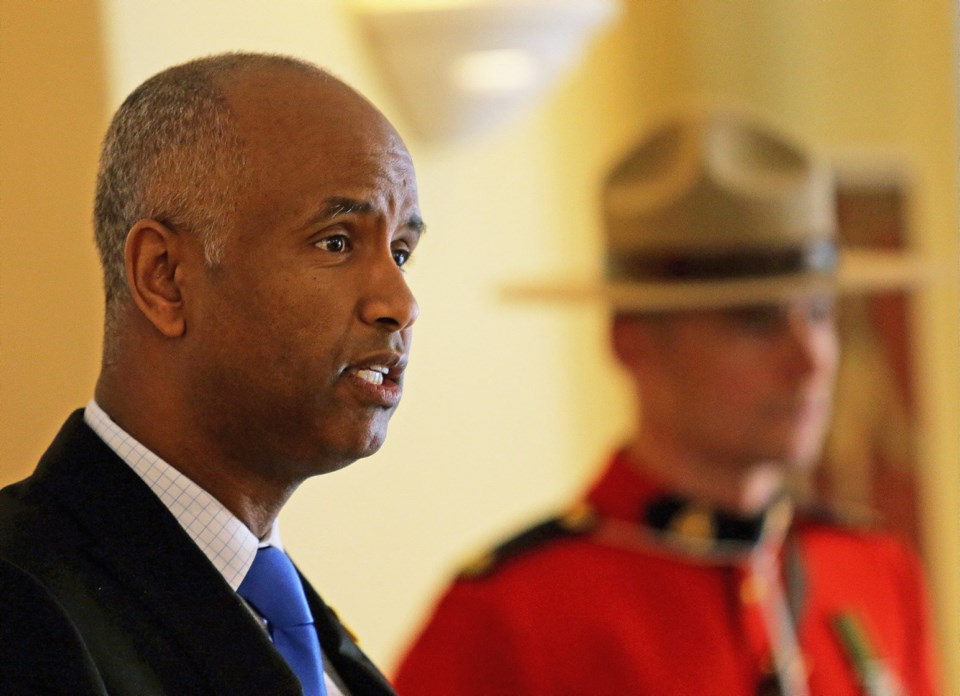Ahmed Hussen has been challenged to roll up his sleeves and see first-hand why business owners in Victoria and other parts of Western Canada are growing frustrated with the federal Immigration, Refugees and Citizenship Ministry.
The federal minister, in Victoria as part of a national tour to highlight the importance of immigration to Canada and its economy, was handed some tough questions during a breakfast meeting with the Greater Victoria Chamber of Commerce.
Having listened to Hussen spend 30 minutes telling the business community that the government has been working to streamline immigration processes while increasing the number of immigrants permitted into Canada each year, Victoria’s business community put him on the spot.
Tom Plumb, chief executive of Kinetic Construction, told Hussen his company has found the immigration system “impossible” and that nothing has changed since the Liberals took power in 2015.
“We needed workers five years ago ... nothing has changed, the system is convoluted, time-consuming and really expensive so it doesn’t really solve our problem,” he said.
Plumb then suggested Hussen get down on the street and watch the immigration process in action.
“That way you will see the root of the problem, and until you do that I don’t think you will,” he said.
Plumb, like many of Thursday’s audience, has grown frustrated at the struggle to use foreign workers to fill massive gaps in the Victoria labour force. At three per cent, the region has the country’s second-lowest unemployment rate, and faces the prospect of thousands of positions going unfilled.
“It’s not a major problem, it’s a crisis,” said Frank Bourree of Chemistry Consulting, which specializes in human resources. “The Liberal government has made some positive changes to the process. However, the timelines are still really long to bring foreign workers in and it’s a very expensive process.”
Bourree said the bureaucracy in charge of the system is the problem, and Hussen would do well to get “into the trenches” to see what really takes place.
During a question-and-answer session with chamber chief executive Catherine Holt, Hussen admitted the work done to improve the system hasn’t solved the problem.
“We want to attract more workers and provide skilled people to the economy. Every single year we have increased immigration numbers because we know Canada needs workers. The challenge is, even that’s not enough,” he said, noting the country expects to bring in about one million permanent residents over the next three years, 72 per cent of those categorized as job fillers or job creators.
Hussen spent much of his time telling the room what it already knew — that Canada is facing a severe labour shortage and that immigration is one answer to that problem. He also said that in some cases, they have cut down waiting times in the immigration process to months from years.
When told Victoria’s workforce is below the national average when it comes to employing immigrants — 18 per cent in Victoria compared with 25 per cent on average — he suggested that might be due in part to new Canadians gravitating to larger centres such as Toronto, Montreal and Vancouver.
Bourree suggested there is clearly still a disconnect between Victoria’s acute labour shortage and what’s happening in Ottawa.
“No one in Ottawa is in a panic about what’s going on in Western Canada,” he said, adding that might have something to do with the national unemployment rate hovering around six per cent.
Holt said there was certainly a gap between Hussen’s answers and the concerns she’s been hearing from Victoria’s business community.
“I take some encouragement from the fact that at least this government is pro-immigration and trying, but there’s a big, long, steep hill between what the minister experiences and what employers here in Victoria are experiencing in trying to figure out how to fill their job vacancies,” she said.
Like Bourree, Holt laid the blame at the feet of the immigration bureaucracy.
“I think it’s a culture in the department, long and deep,” she said. “You can’t turn a machine like that around in a few years.”
Currently caught in those gears is Victoria high-tech entrepreneur Samarth Mod.
The chief executive of FreshWorks came to Canada in 2013 and has since built a business that has created more than 75 jobs.
Mod, a permanent resident, is applying for citizenship, but told Hussen he has found the process much more onerous as an entrepreneur than the path faced by regular immigrants.
When Mod asked why it’s more difficult, Hussen would only say that the previous government axed immigrant entrepreneur and investment programs for not living up to economic expectations.
In an interview, Mod said that answer doesn’t help him. “It’s frustrating because I know there’s a huge backlog, but as an entrepreneur that is here creating jobs ... it feels almost demoralizing,” he said.



